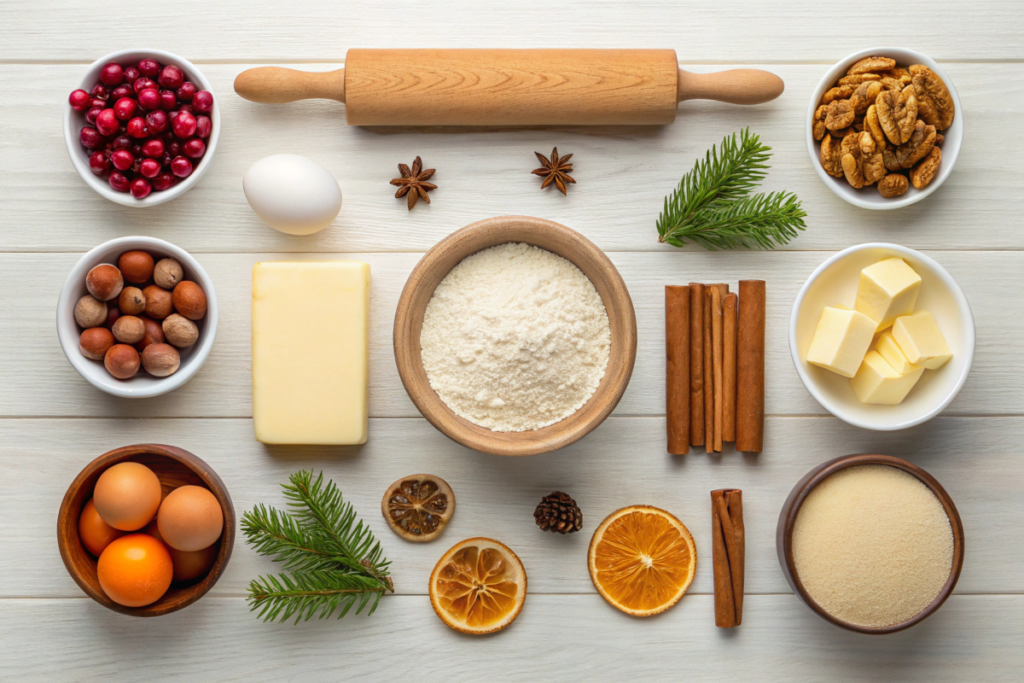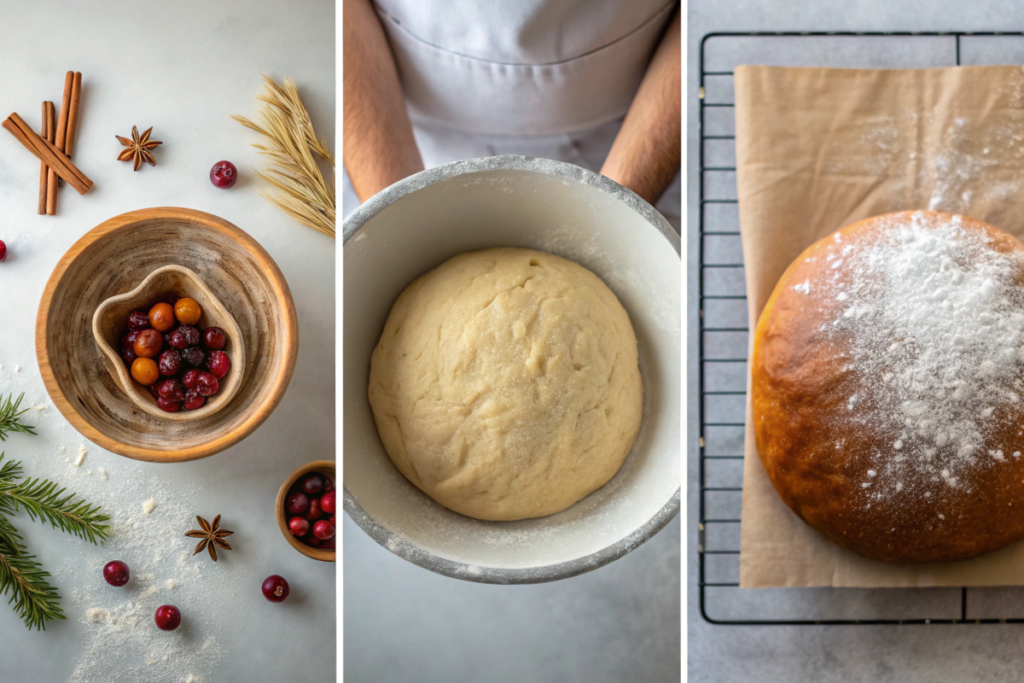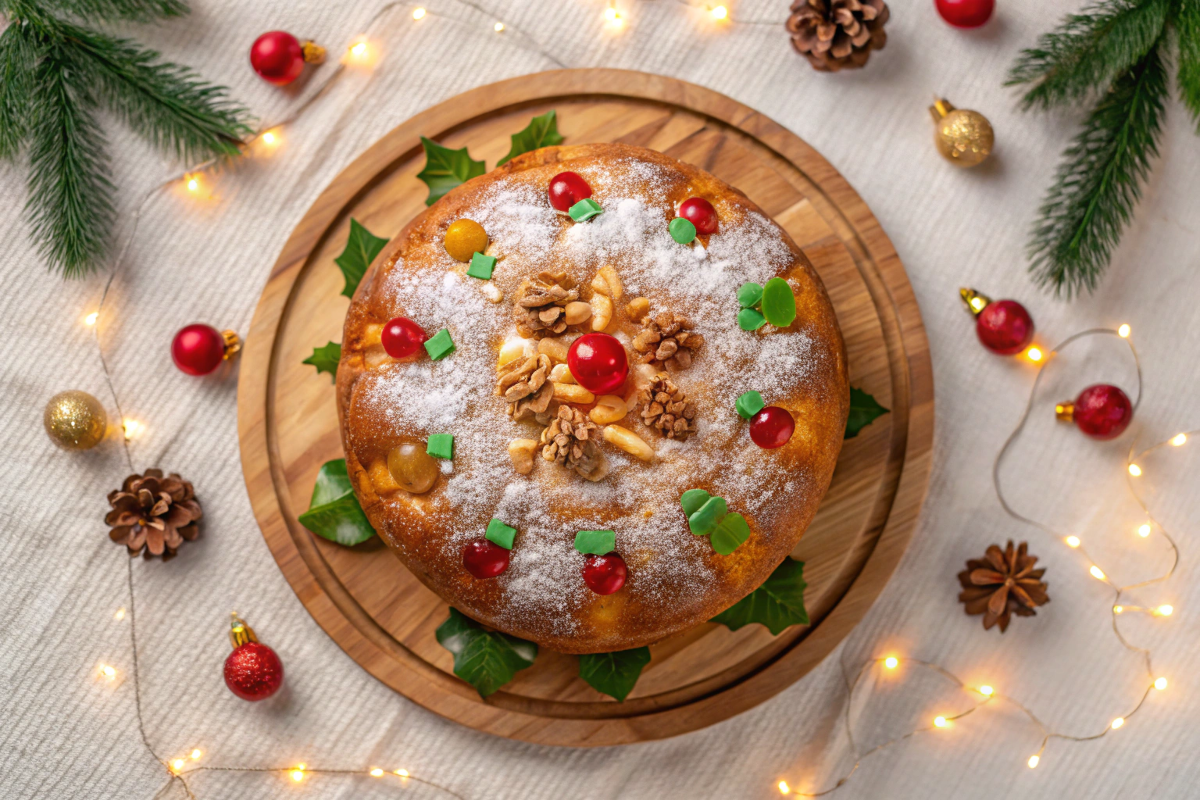Introduction to Christmas Bread Recipes
Christmas bread plays an important role in holiday traditions worldwide. It combines sweet and savory flavors with festive spices to create a comforting and delicious treat. Whether you serve it as a breakfast dish, snack, or dessert, Christmas bread recipe options bring warmth and joy to the holiday season. Moreover, its beautiful presentation often makes it a centerpiece at many holiday gatherings. For more holiday recipe inspiration, explore our Recipe Categories for Christmas.
What Is Christmas Bread?
Christmas bread includes a variety of festive baked goods made especially for the holiday season. Bakers often enrich these breads with ingredients like dried fruits, nuts, warm spices, and sweeteners such as honey or sugar. Additionally, many recipes incorporate unique touches like citrus zest, chocolate, or liqueurs to enhance their festive flavors.
Some Christmas breads, like Panettone, feel light and airy, while others, such as Stollen, contain denser fillings that create a rich texture. Furthermore, the diversity in recipes reflects traditions and flavors from different cultures. For instance, Italy’s Panettone rises tall and fluffy, while Scandinavia’s Lussekatter features saffron-infused dough twisted into intricate shapes.
Christmas bread delights the palate and pleases the eye. Bakers frequently decorate these loaves with powdered sugar, glazes, or candied fruits, making them a visual feast as well.
The History and Significance of Christmas Bread
The tradition of Christmas bread goes back centuries, originating in religious ceremonies and festive celebrations. In medieval times, people considered bread a symbol of abundance and goodwill. Families used rare and expensive ingredients like spices and dried fruits to celebrate prosperity and joy during the holidays.
Various cultures developed their own styles of Christmas bread, reflecting local ingredients and customs. For example, German bakers created Stollen, a fruit-filled bread dusted with powdered sugar, symbolizing the swaddled Christ child. Meanwhile, Italian bakers perfected Panettone as a symbol of indulgence, gifting it during the holiday season. Additionally, Scandinavians crafted Lussekatter, shaped into S-shapes and dyed with saffron, to celebrate St. Lucia’s Day with its golden hue.
The meaning of Christmas bread goes beyond its ingredients. It represents togetherness, as families and communities come together to bake and share these treats. Today, this beloved tradition continues to bring warmth and cheer to holiday celebrations worldwide.
Essential Ingredients for Christmas Bread
Creating Christmas bread begins with the right ingredients. From traditional staples to unique seasonal additions, the components of Christmas bread bring warmth, flavor, and festive charm. Additionally, choosing ingredients tailored to dietary needs ensures everyone can enjoy this holiday classic.
Traditional Ingredients: Flour, Yeast, and Spices
- Flour:
- Most Christmas bread recipes use all-purpose or bread flour for structure and softness. Additionally, some variations include whole wheat flour for a heartier texture.
- Yeast:
- Yeast is the key to creating a light and fluffy bread. Active dry yeast and instant yeast both work well, depending on the recipe.
- Spices:
- Warm spices like cinnamon, nutmeg, and cloves define the festive aroma of Christmas bread. Moreover, cardamom and ginger are often used to add depth and complexity.
- Milk and Butter:
- These ingredients enrich the dough, giving it a tender texture. For instance, adding butter creates a rich flavor that pairs perfectly with sweet additions.
Different Options for Dietary Needs
- Gluten-Free Flour:
- Use gluten-free all-purpose flour blends to make Christmas bread suitable for those with gluten intolerance.
- Dairy-Free Alternatives:
- Replace milk with almond, soy, or oat milk, and use plant-based butter for a vegan-friendly option.
- Sugar Substitutes:
- Opt for natural sweeteners like stevia, monk fruit, or coconut sugar to reduce added sugar content. Additionally, maple syrup or honey works well in place of traditional sugar.
- Low-Carb Options:
- Almond or coconut flour creates keto-friendly Christmas bread, while erythritol can substitute for sugar.
- Egg Substitutes:
- Replace eggs with flaxseed meal or applesauce to cater to vegan or egg-free diets.
Seasonal Additions: Dried Fruits, Nuts, and Citrus
- Dried Fruits:
- Traditional recipes often include raisins, currants, or cranberries. Additionally, dried apricots or figs can add a unique twist.
- Nuts:
- Add crunch and flavor with chopped almonds, walnuts, or pecans. Moreover, pistachios provide a festive green hue that enhances the bread’s appearance.
- Candied Citrus Peel:
- Candied orange or lemon peel brings a sweet, tangy flavor. For a fresher touch, grated citrus zest can be used instead.
- Spiced Mix-Ins:
- Incorporate spiced nuts or crystallized ginger for an added layer of holiday flavor.
Choosing the Right Sweeteners and Toppings
- Sweeteners:
- Granulated sugar is a common choice, but brown sugar adds a deeper, molasses-like flavor. Additionally, honey or maple syrup provides natural sweetness.
- Powdered Sugar:
- Dusting the finished bread with powdered sugar creates a snowy, festive look.
- Glazes:
- For a shiny finish, brush the bread with a simple sugar glaze or a mixture of honey and water. Moreover, cream cheese glazes work well for sweeter bread varieties.
- Toppings:
- Sprinkle slivered almonds, coarse sugar, or dried fruits over the bread before baking to enhance both taste and appearance.
- Chocolate Drizzle:
- Add melted dark or white chocolate for an indulgent finishing touch. Additionally, you can sprinkle crushed candy canes for a festive twist.

Step-by-Step Christmas Bread Recipe
Making Christmas bread is a rewarding process that fills your home with festive aromas and results in a delicious holiday treat. Follow these steps to prepare, flavor, and bake the perfect Christmas bread.
Preparing the Dough: Mixing and Kneading
- Gather Ingredients:
- Start with your base ingredients: flour, yeast, sugar, warm milk, eggs, and butter. Additionally, have your spices, dried fruits, and nuts ready for later steps.
- Activate the Yeast:
- Dissolve yeast in warm milk with a pinch of sugar. Let it sit for 5–10 minutes until it becomes frothy. This step ensures the yeast is active and ready to help your dough rise.
- Mix the Dough:
- In a large bowl, combine the flour, sugar, and spices like cinnamon or nutmeg. Gradually add the yeast mixture, eggs, and melted butter. Mix until a sticky dough forms.
- Knead the Dough:
- Transfer the dough to a floured surface and knead for 8–10 minutes. Alternatively, use a stand mixer with a dough hook for 5–6 minutes. The dough should become smooth and elastic.
- Initial Rest:
- Place the kneaded dough in a greased bowl, cover it with a clean towel, and let it rest in a warm spot for 1–2 hours. During this time, the dough will double in size.
Adding Festive Flavors: Incorporating Fruits and Spices
- Prepare Add-Ins:
- Chop dried fruits like raisins, cranberries, or apricots. Toast nuts such as almonds or walnuts to enhance their flavor. Additionally, grate citrus zest or chop candied peel for extra zestiness.
- Mix Into the Dough:
- Once the dough has risen, gently deflate it and knead in the dried fruits, nuts, and spices. Be careful not to overwork the dough, as this could disrupt its texture.
- Even Distribution:
- Ensure the fruits and nuts are evenly distributed throughout the dough. This guarantees every slice of bread will have a consistent festive flavor.
- Optional Additions:
- For extra sweetness, incorporate small chocolate chips or drizzle honey over the dough before shaping.
Shaping, Proofing, and Baking
- Shape the Dough:
- Depending on your recipe, shape the dough into a loaf, braid, or ring. For example, Panettone is traditionally baked in a tall, round mold, while Stollen is shaped into a folded log.
- Second Proofing:
- Place the shaped dough on a lined baking sheet or in a greased pan. Cover it with a towel and let it rise again for 30–60 minutes. This step helps the bread maintain its shape and achieve a light texture.
- Preheat the Oven:
- While the dough proofs, preheat your oven to 350°F (175°C).
- Bake the Bread:
- Bake the bread in the preheated oven for 25–40 minutes, depending on its size and shape. Keep an eye on it; the bread is ready when it turns golden brown and sounds hollow when tapped.
- Cooling and Finishing:
- Allow the bread to cool completely on a wire rack before slicing. For added festive flair, dust with powdered sugar, glaze with icing, or drizzle melted chocolate.

Popular Variations of Christmas Bread
Christmas bread comes in many forms, each reflecting the unique traditions and flavors of its origin. From the airy Panettone to the rich German Stollen, these variations bring festive warmth and joy to holiday tables.
Classic Panettone: Italian Christmas Bread
Panettone is a light, fluffy bread with a sweet and fruity flavor, making it a beloved centerpiece of Italian Christmas celebrations. Its tall, domed shape comes from being baked in special molds, which gives it a distinct appearance.
Key Features:
- Panettone dough is enriched with butter, eggs, and sugar, giving it a soft and tender texture.
- Candied orange peel and raisins are the traditional mix-ins, though modern variations may include chocolate chips or dried cherries.
Serving Tips:
Panettone is often served sliced, accompanied by coffee, tea, or sweet wine. Additionally, it can be toasted lightly and topped with butter or jam for a delightful breakfast treat.
Why It’s Special:
The long proofing process allows Panettone to develop its signature airy texture and subtle sweetness. Moreover, its versatility and elegant presentation make it a festive favorite around the world.
German Stollen: A Festive Favorite
Stollen, also known as Christstollen, is a dense and flavorful bread that originated in Germany. It has a rich history dating back to the 15th century, when it was first created as a symbolic treat for the Advent season.
Key Features:
- Stollen dough includes butter, spices like cinnamon and cardamom, and dried fruits such as raisins and currants.
- Marzipan, a sweet almond paste, is often added to the center for an extra layer of indulgence.
Serving Tips:
Stollen is typically dusted with powdered sugar, resembling a snow-covered log. Slice it thickly and serve it with mulled wine or coffee for a classic German holiday experience.
Why It’s Special:
Its combination of rich flavors and hearty texture makes Stollen a satisfying holiday treat. Furthermore, its long shelf life allows it to be made in advance and enjoyed throughout the Christmas season.
Sweet Brioche and Other International Variations
Brioche, a soft and buttery bread, serves as the base for many sweet Christmas bread recipes worldwide. While it is simple on its own, bakers often enhance it with festive flavors and decorations.
Key Features:
- Brioche dough uses a high ratio of butter and eggs, resulting in a rich and fluffy texture.
- Variations may include fillings like chocolate, cream cheese, or fruit preserves. Additionally, toppings like pearl sugar or almond slivers add a festive touch.
Other International Variations:
- France: Bûche de Noël-inspired brioche with chocolate and hazelnut.
- Spain: Roscón de Reyes, a ring-shaped bread with candied fruit and a hidden surprise.
- Scandinavia: Lussekatter, saffron-infused buns shaped into intricate designs.
Why It’s Special:
Brioche-based Christmas breads are adaptable to different cultural traditions, making them a versatile option for holiday baking. Moreover, their pillowy texture and rich flavor ensure they’re always a crowd-pleaser.
Creative Twists on Christmas Bread Recipes
Traditional Christmas bread recipes are timeless, but adding a creative twist can make them even more special. Whether you’re looking to indulge with chocolate or create giftable treats, these variations add fun and flavor to your holiday baking.
Chocolate Christmas Bread
Chocolate Christmas bread combines the festive essence of traditional recipes with the decadence of rich cocoa. This version is perfect for chocolate lovers and adds a modern twist to the holiday classic.
How It’s Made:
- Base Dough: Start with a traditional Christmas bread dough made with flour, yeast, and butter.
- Chocolate Additions: Incorporate cocoa powder into the dough for a deep chocolate flavor. Additionally, fold in chocolate chips or chunks for bursts of sweetness.
- Optional Enhancements: Add spices like cinnamon or cardamom to complement the chocolate. For a festive touch, mix in dried cherries or orange zest.
Serving Ideas:
- Serve warm slices with a dollop of whipped cream or a drizzle of chocolate glaze.
- Toast leftovers lightly and spread with butter for a delicious breakfast treat.
Why It’s Special:
Chocolate Christmas bread combines indulgence and tradition, making it a hit with both kids and adults. Moreover, its rich flavor and eye-catching presentation make it a standout addition to your holiday table.
Miniature Christmas Bread Loaves for Gifting
Miniature Christmas bread loaves are a thoughtful and festive gift for friends, family, or neighbors. They’re easy to personalize and offer a charming way to share holiday cheer.
How It’s Made:
- Divide the Dough: Use a standard Christmas bread dough recipe and divide it into smaller portions.
- Shaping and Baking: Shape each portion into a small loaf and bake in individual loaf pans or molds. Additionally, ensure the loaves are evenly sized for consistent baking.
- Personalized Additions: Customize each loaf with different mix-ins, such as cranberries, chocolate chips, or candied orange peel.
Packaging Tips:
- Wrap each loaf in festive parchment paper or cellophane, tied with holiday ribbon.
- Add a gift tag with the loaf’s flavor and a handwritten holiday message.
Why It’s Special:
Miniature loaves are both practical and personal. Not only are they easy to transport, but they also let you spread joy to multiple recipients.
FAQs About Christmas Bread Recipe
What Are the Most Popular Christmas Bread Recipes?
Panettone, Stollen, and Brioche are among the most loved.
Can I Make Christmas Bread Ahead of Time?
Yes, bake it in advance and store it in an airtight container or freeze it.
What Are Some Substitutes for Common Allergens?
Use gluten-free flour, plant-based milk, and flaxseed as an egg substitute.
Conclusion
Creative twists like chocolate bread and miniature loaves add excitement to traditional Christmas recipes. These variations are perfect for indulgence or gifting, making your holiday baking even more special!

